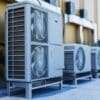Water damage is a common issue faced by homeowners and property managers worldwide. Water intrusion can wreak havoc on a property from a burst pipe, heavy rainfall, or a leaking roof, leading to structural damage, mold growth, and various health hazards.
While the visible damage might seem like the primary concern, the health risks associated with water damage are equally significant, often lurking beneath the surface. This comprehensive blog post will delve deeper into the ten health risks linked to water damage, exploring their implications and emphasizing the critical role of water damage restoration in safeguarding both property and health.
Mold Growth
Mold growth is one of the most immediate and pervasive health risks associated with water damage. These are ubiquitous in the environment, but when they encounter moisture on water-damaged surfaces, they can rapidly multiply, forming colonies within as little as 24 to 48 hours. Exposure to mold spores can trigger allergic reactions and respiratory issues and exacerbate existing conditions such as asthma and allergies.
Furthermore, certain types of mold, such as black mold (Stachybotrys chartarum), produce mycotoxins that can have severe health effects when inhaled or ingested. These toxins have been linked to respiratory problems, neurological symptoms, and immune system suppression.
Respiratory Issues
Prolonged exposure to mold, dampness, and airborne contaminants resulting from water damage can significantly impact respiratory health. Individuals may experience a range of symptoms, including coughing, wheezing, shortness of breath, and chest tightness.
Those with pre-existing respiratory conditions, such as asthma or chronic obstructive pulmonary disease (COPD), are particularly vulnerable to the effects of indoor mold exposure. Mold spores and other allergens can irritate the respiratory tract, leading to inflammation and increased susceptibility to respiratory infections.
Bacterial Contamination
Water damage, especially when it involves sewage backups or flooding, can introduce harmful bacteria and pathogens into the indoor environment. Contaminated water may contain a variety of bacteria, including Escherichia coli (E. coli), Salmonella, and Legionella, which can cause gastrointestinal illnesses, skin infections, and respiratory diseases.
Exposure to these pathogens can occur through direct contact with contaminated water or inhalation of aerosolized droplets. Proper sanitation and disinfection are essential to mitigate the risk of bacterial contamination and protect occupants’ health.
Structural Damage
In addition to posing health risks, water damage can compromise the structural integrity of a building over time. Damp conditions promote the growth of fungi, such as mold and rot, which can weaken wood, corrode metal, and degrade building materials.
Structural components, including walls, floors, ceilings, and foundations, may become weakened or warped, increasing the risk of collapse or structural failure. Structural damage not only threatens the safety of occupants but also requires costly repairs to restore the integrity of the building.
Electrical Hazards
Water intrusion poses significant electrical hazards within a property, increasing the risk of electrical fires, short circuits, and electrocution. Moisture can penetrate electrical systems, outlets, and appliances, compromising their safety and functionality.
Exposed wiring or electrical components submerged in water can become energized, leading to shock hazards for anyone in contact with them. It’s crucial to exercise caution around electrical equipment and seek professional assistance to assess and address any electrical hazards resulting from water damage.
Slip-and-Fall Accidents
Water pooling on floors due to leaks, flooding, or plumbing issues creates slippery surfaces, increasing the risk of slip-and-fall accidents. These accidents can result in a range of injuries, from minor bruises to fractures or head trauma.
Elderly individuals, children, and individuals with mobility issues are particularly susceptible to slip-and-fall accidents in water-damaged environments. Proper water extraction, drying, and surface treatments are essential to eliminate slip hazards and ensure a safe indoor environment.
Chemical Contamination
In cases of flooding or water damage involving industrial facilities or hazardous materials, chemical contamination becomes a significant concern. Floodwaters may carry pollutants, toxins, and harmful chemicals from nearby sources, posing a threat to human health and the environment.
Exposure to chemical contaminants can cause skin irritation, respiratory problems, and systemic toxicity, depending on the type and concentration of chemicals involved. Thorough decontamination and cleanup are necessary to mitigate the risk of chemical exposure and protect occupants’ health.
Pest Infestations
Water damage creates ideal conditions for pest infestations, attracting insects, rodents, and other vermin seeking moisture and shelter. Cockroaches, rodents, and dust mites thrive in damp environments, exacerbating allergies and asthma symptoms in occupants.
Pest infestations not only pose health risks but also cause property damage and sanitation issues. Integrated pest management strategies, combined with water damage restoration efforts, are essential to prevent infestations and maintain a healthy indoor environment.
Mental Health Effects
The stress and disruption caused by water damage can significantly affect mental health and well-being. The sudden loss of property, displacement from home, and financial strain can lead to feelings of anxiety, depression, and emotional distress among affected individuals.
Children, elderly individuals, and those with pre-existing mental health conditions may be particularly vulnerable to the psychological impact of water damage incidents. Access to support services, including counseling and community resources, is essential to address the emotional toll of water damage and facilitate recovery for occupants and residents.
Long-Term Health Implications
Ignoring water damage or inadequate restoration efforts can have long-term health implications for occupants and residents. Chronic exposure to mold, dampness, and indoor pollutants may increase the risk of developing respiratory conditions, allergic disorders, or immune system dysfunction over time.
Additionally, structural damage resulting from water intrusion can compromise the integrity of the building, posing ongoing safety hazards for occupants. Addressing water damage promptly and thoroughly is crucial for preventing long-term health consequences and preserving indoor air quality and structural integrity.
Conclusion
Water damage poses a myriad of health risks that extend beyond visible property damage, emphasizing the importance of prompt and effective restoration measures. From mold growth and respiratory issues to structural damage and electrical hazards, the consequences of water intrusion can be severe and far-reaching.
Water damage restoration professionals play a critical role in mitigating these risks, restoring properties to a safe and healthy condition for occupants.
Homeowners and property managers can protect the well-being of their families, tenants, and communities by understanding the health hazards associated with damage and prioritizing comprehensive restoration efforts.
Investing in water damage restoration is not only essential for preserving property value but also for safeguarding the health and safety of building occupants for years to come.









